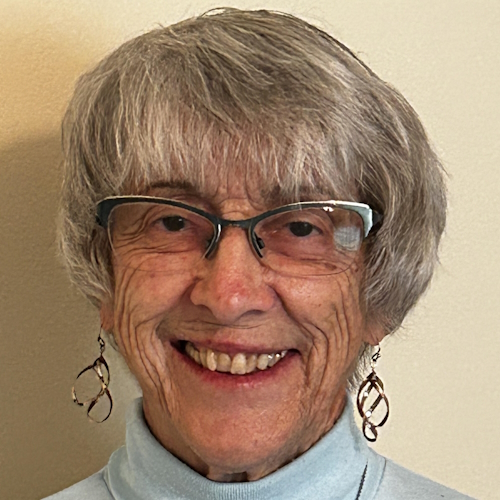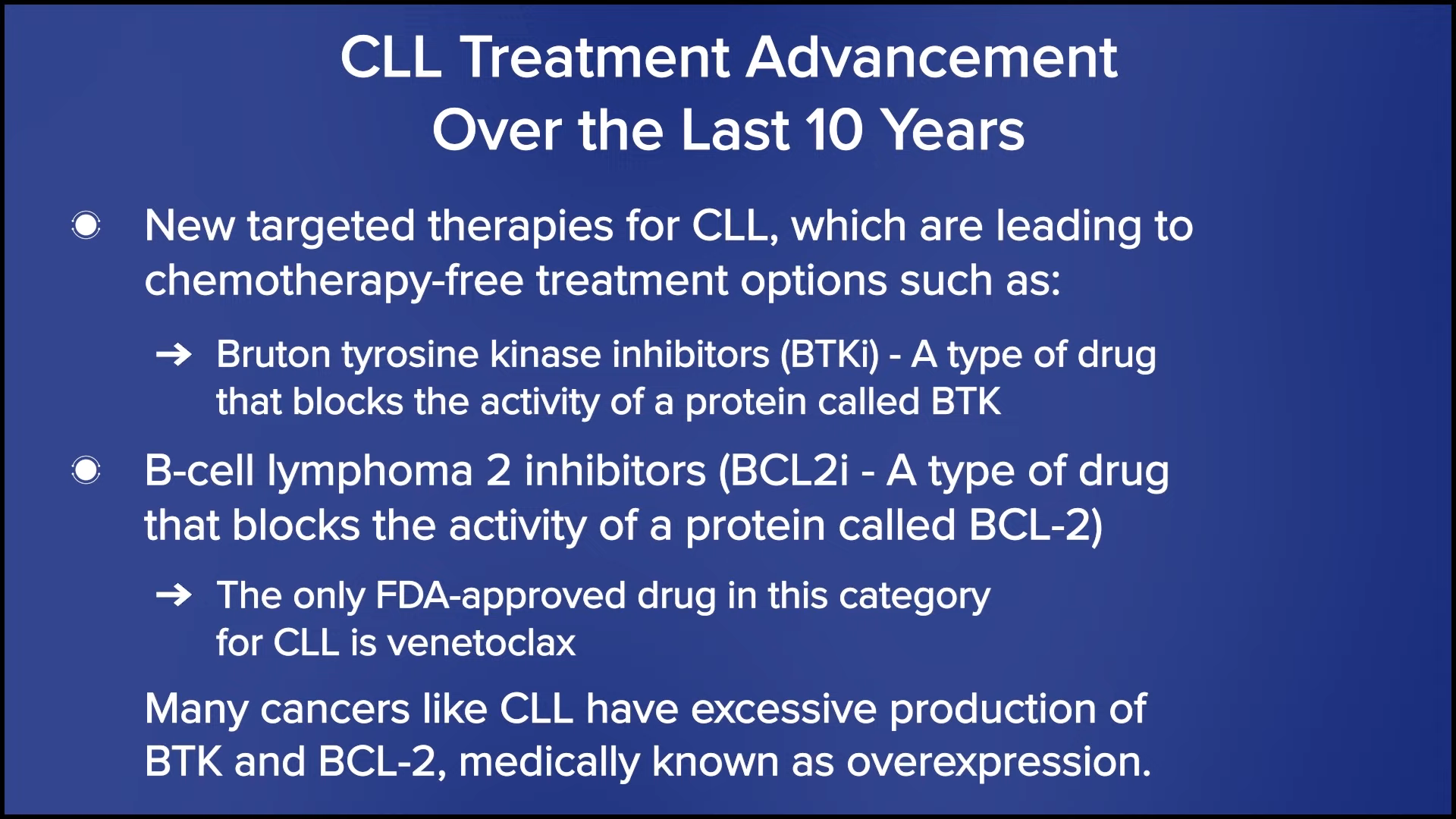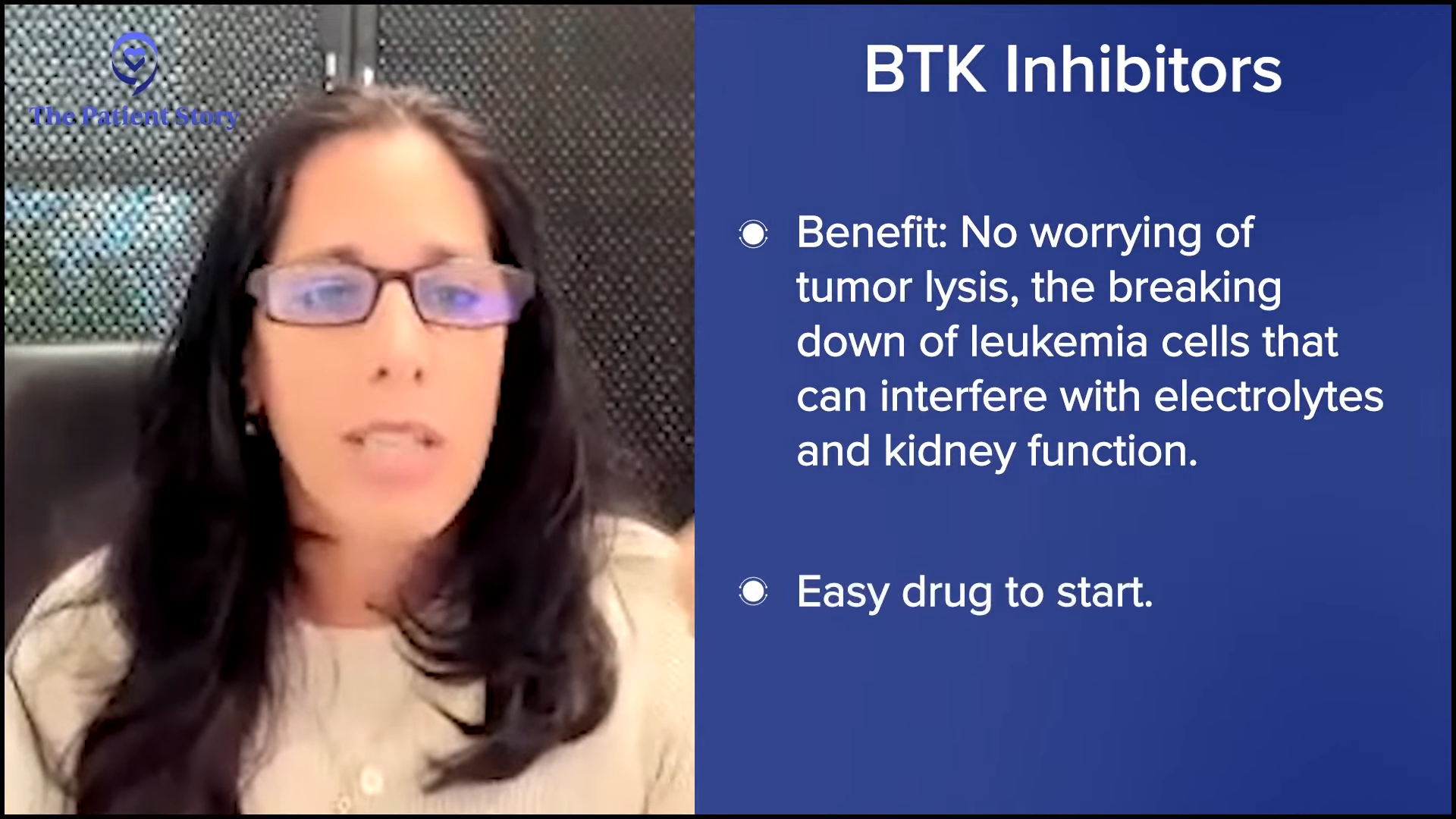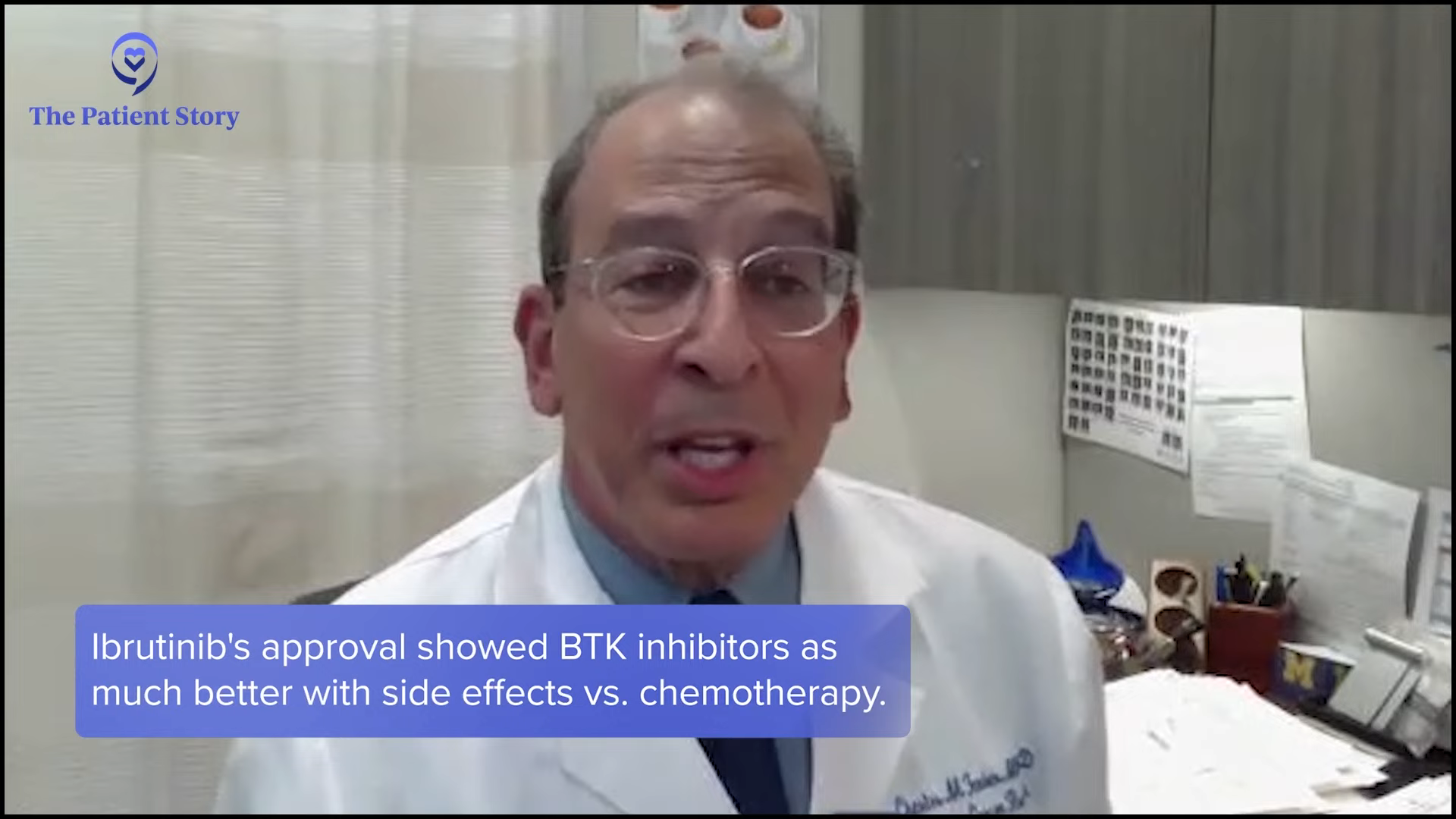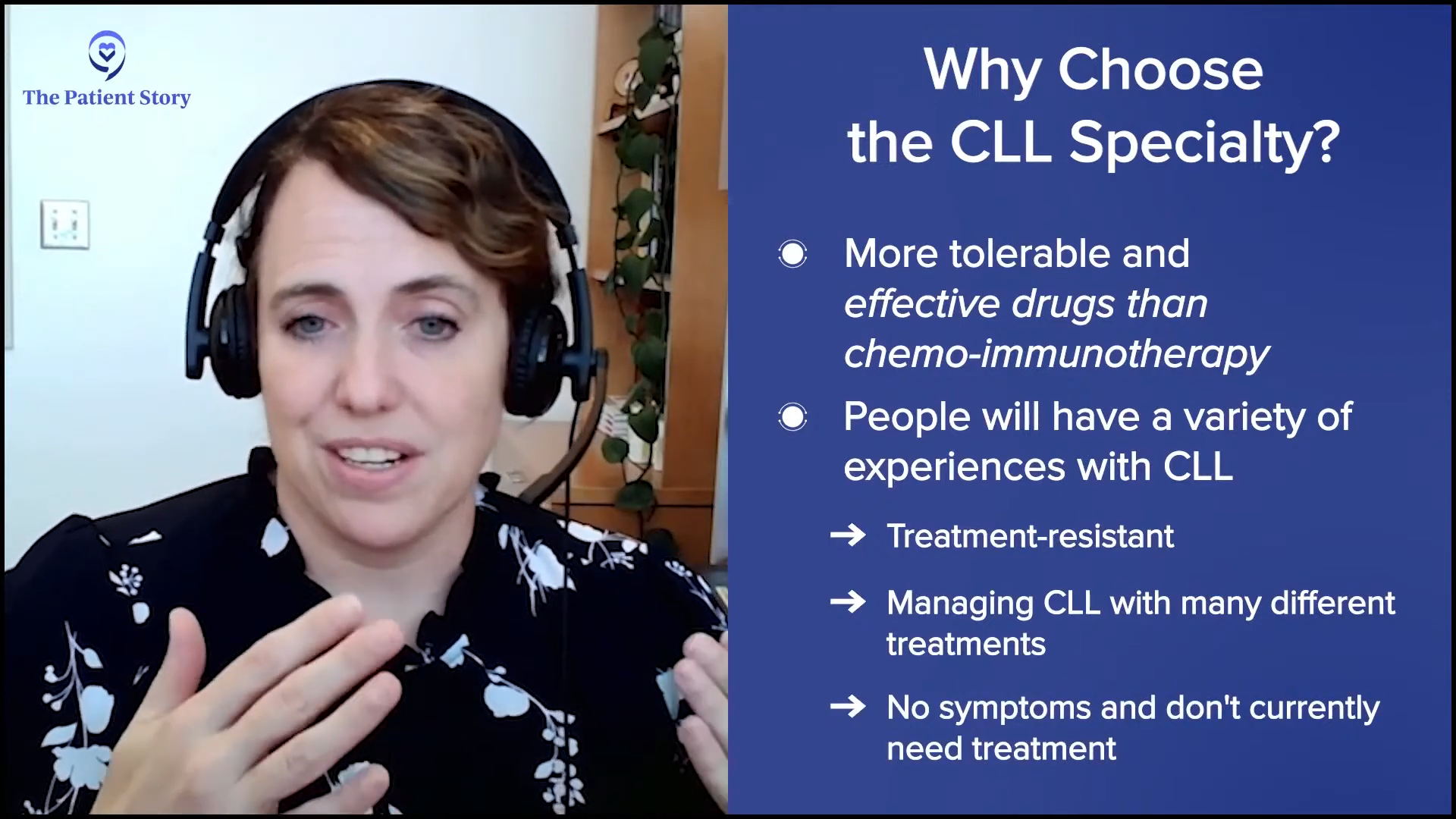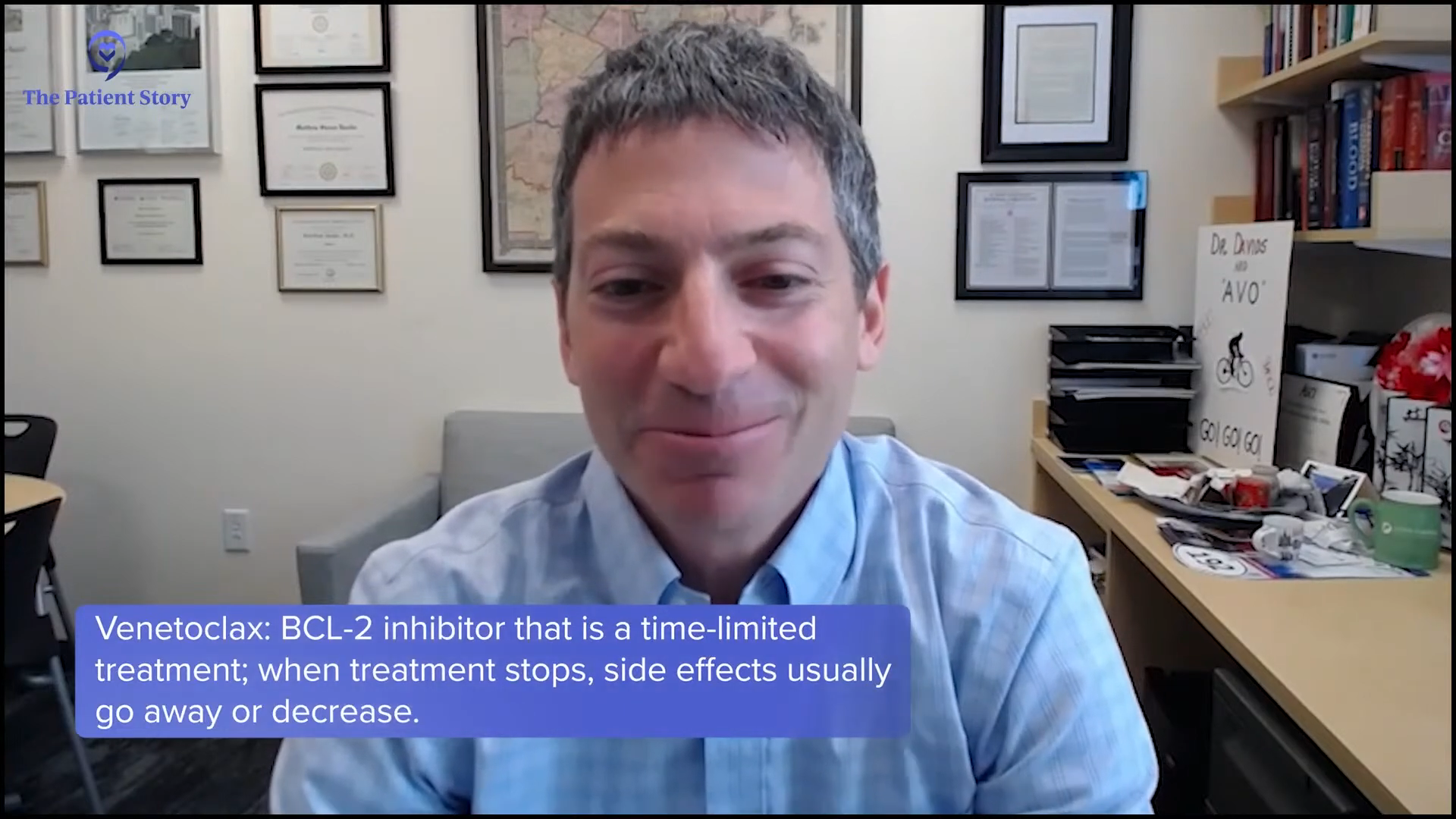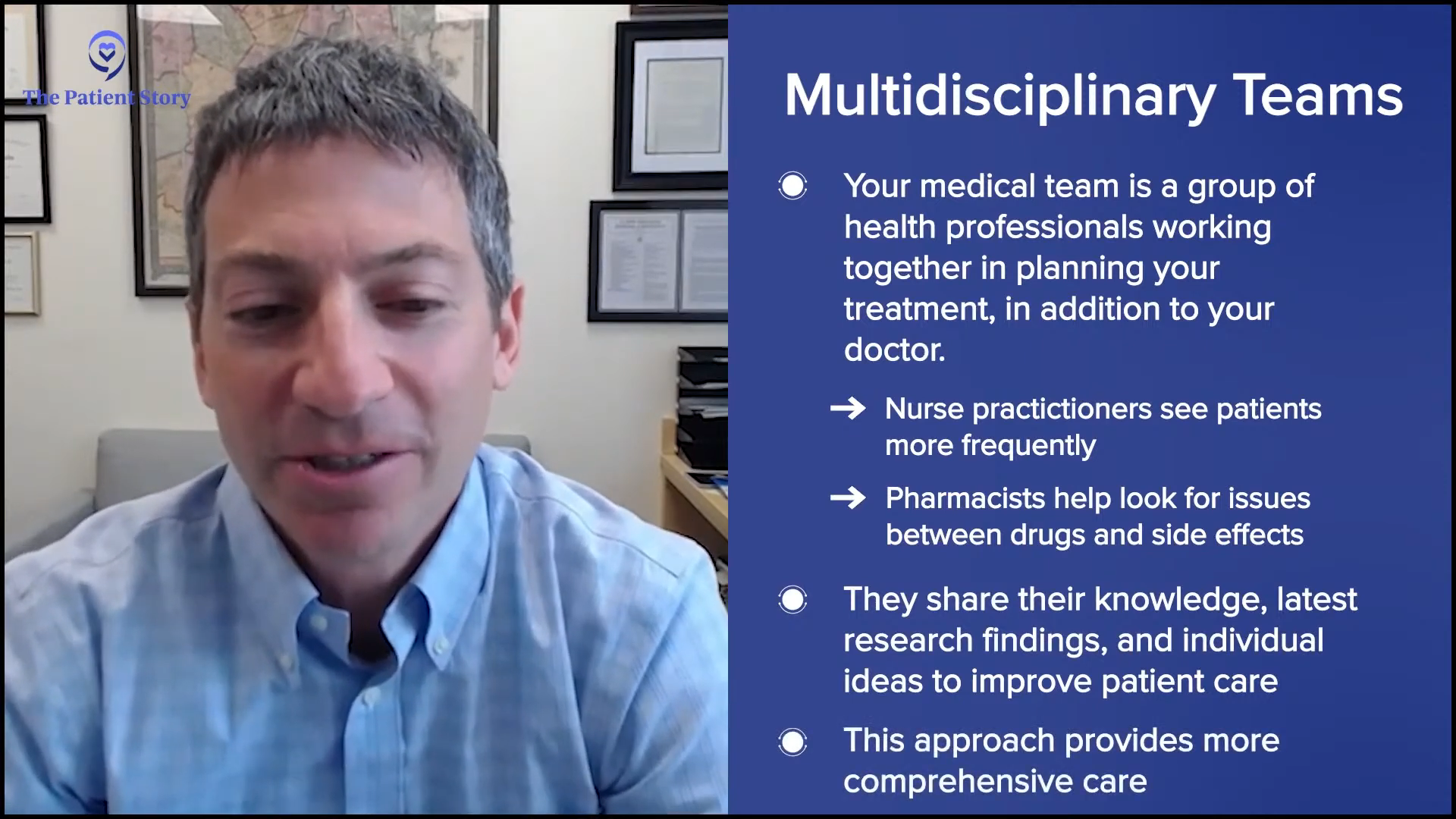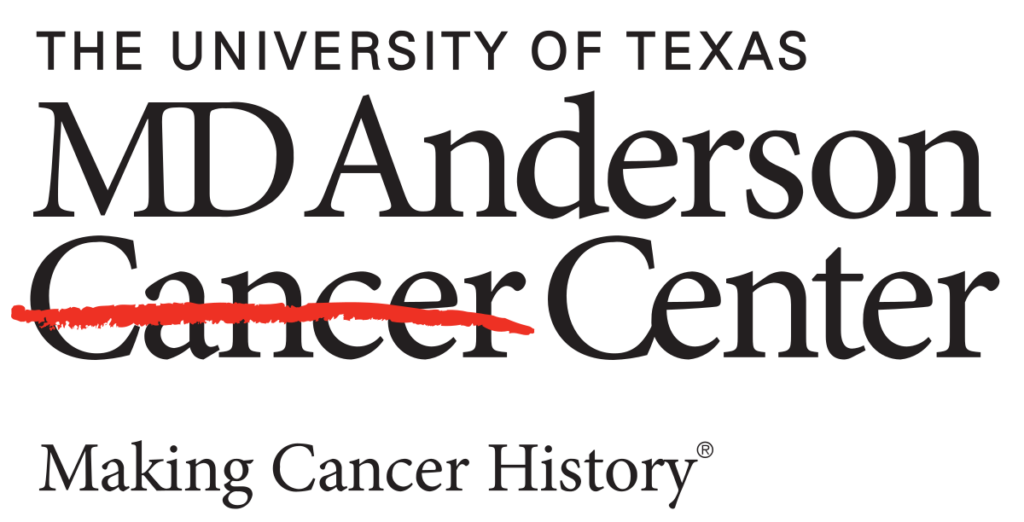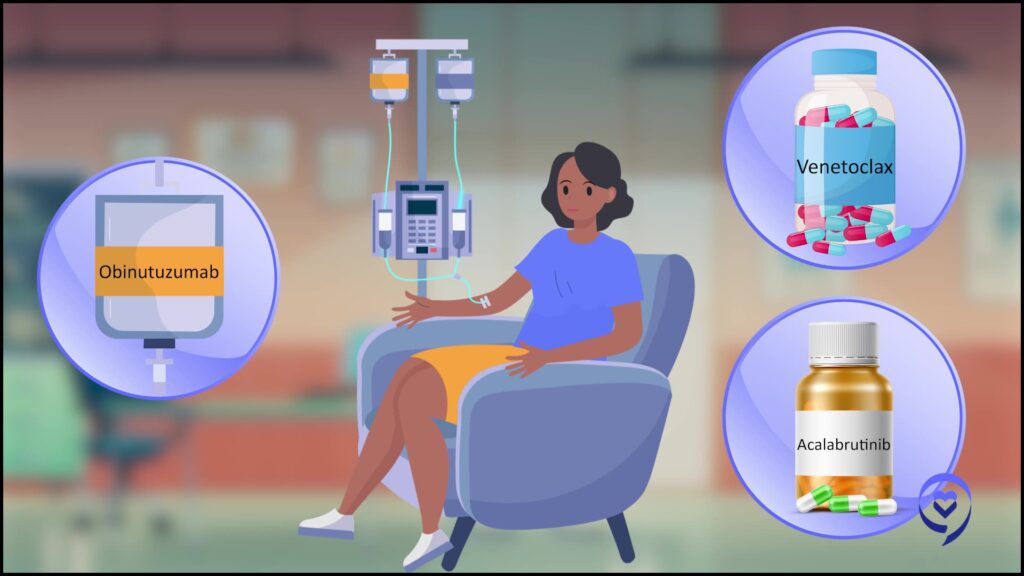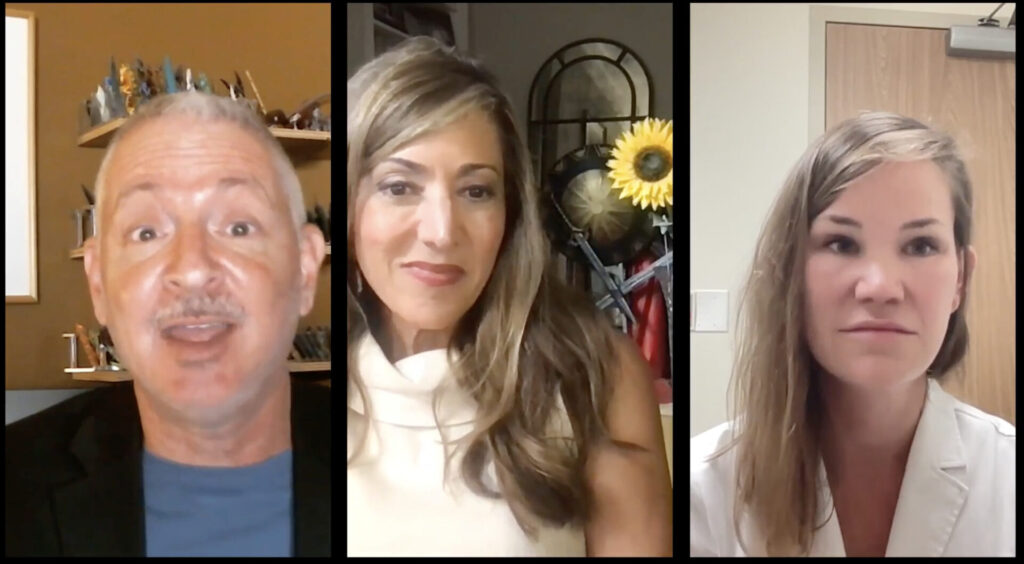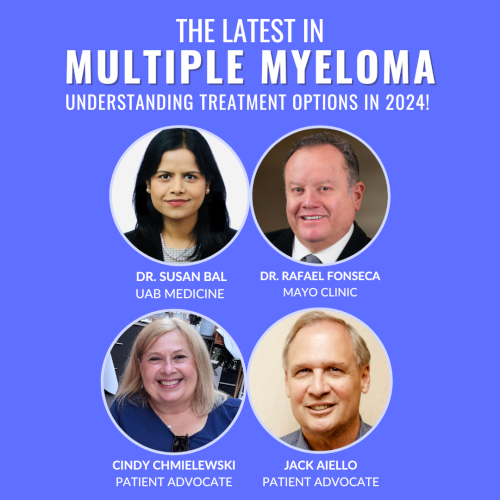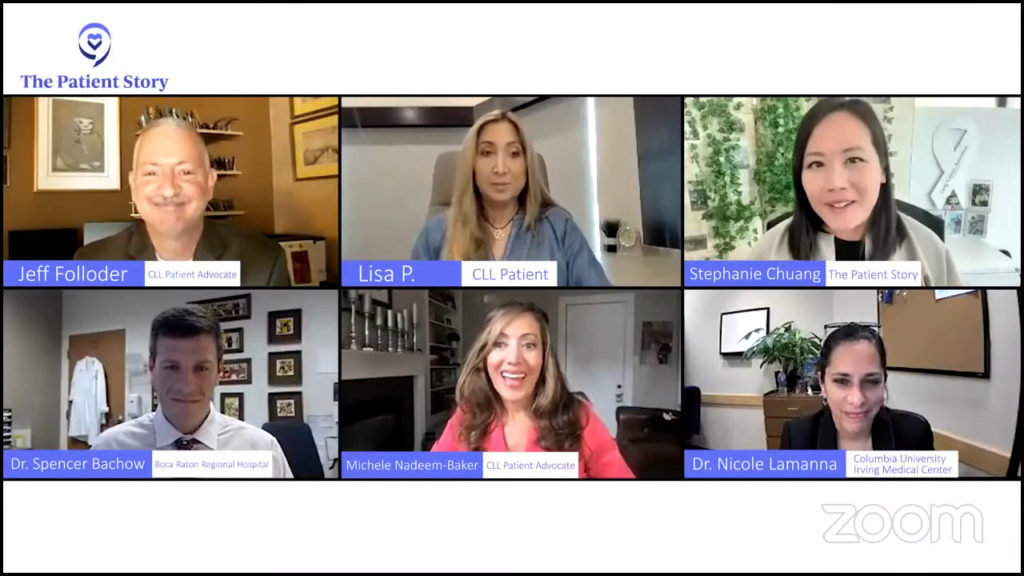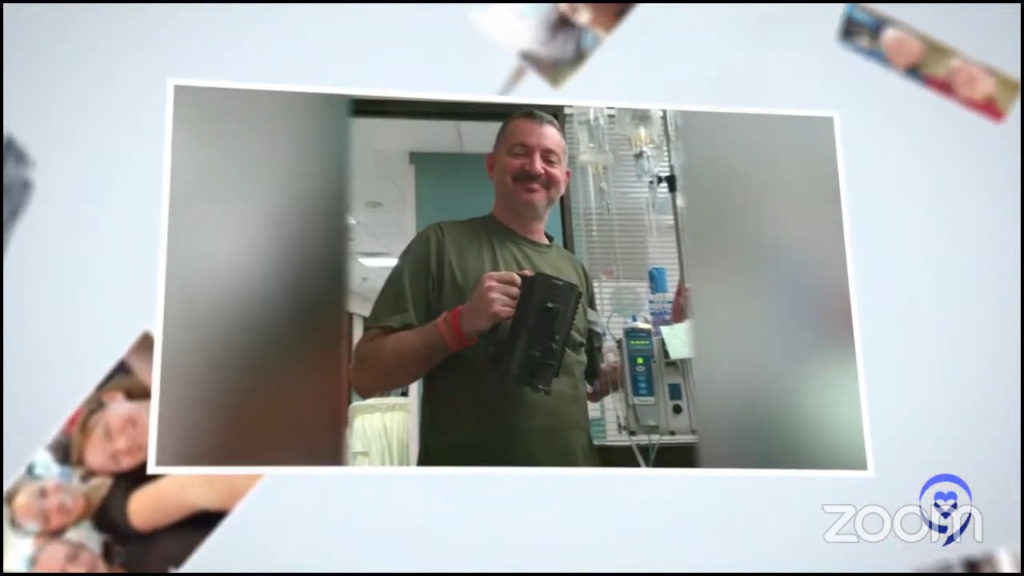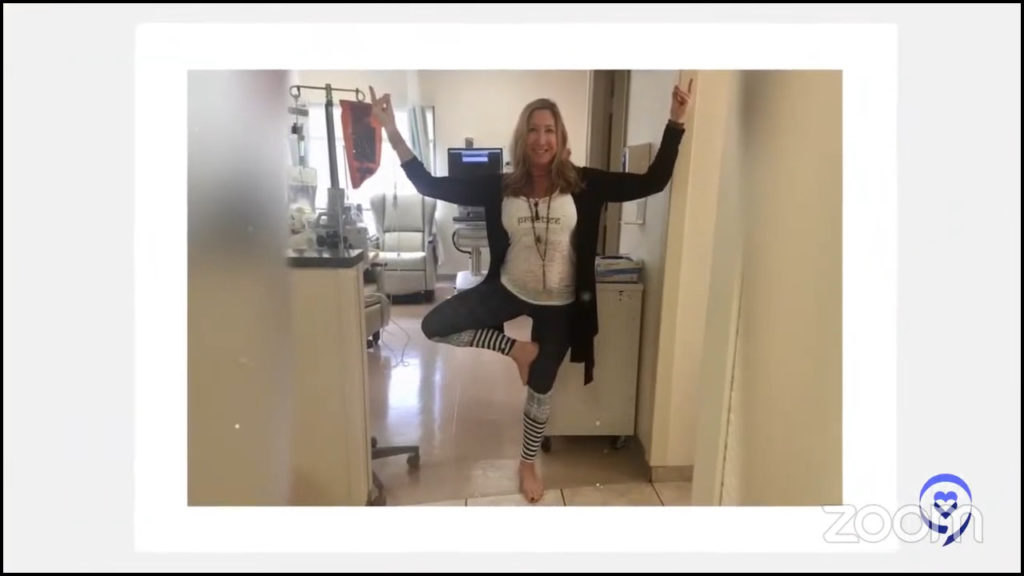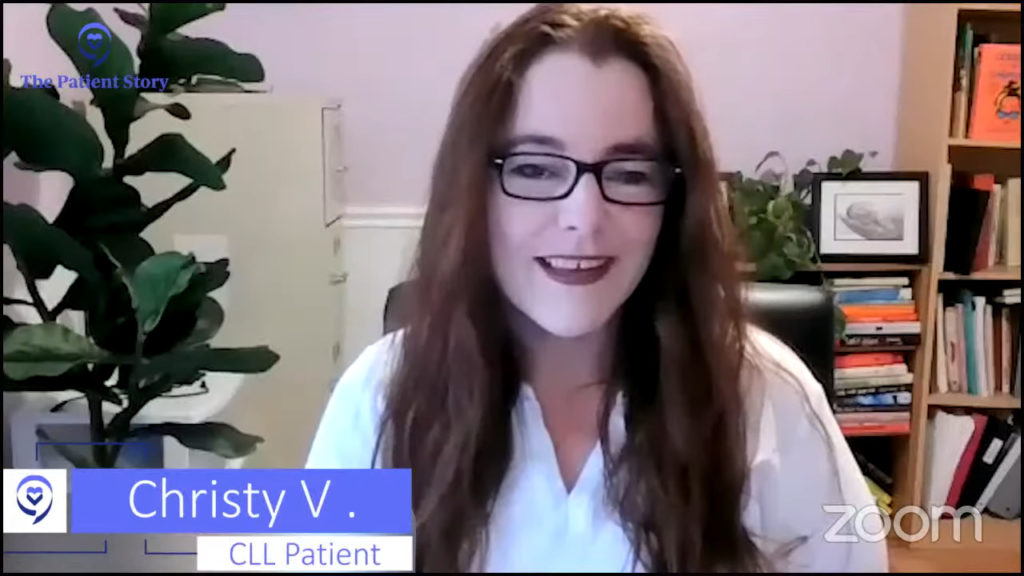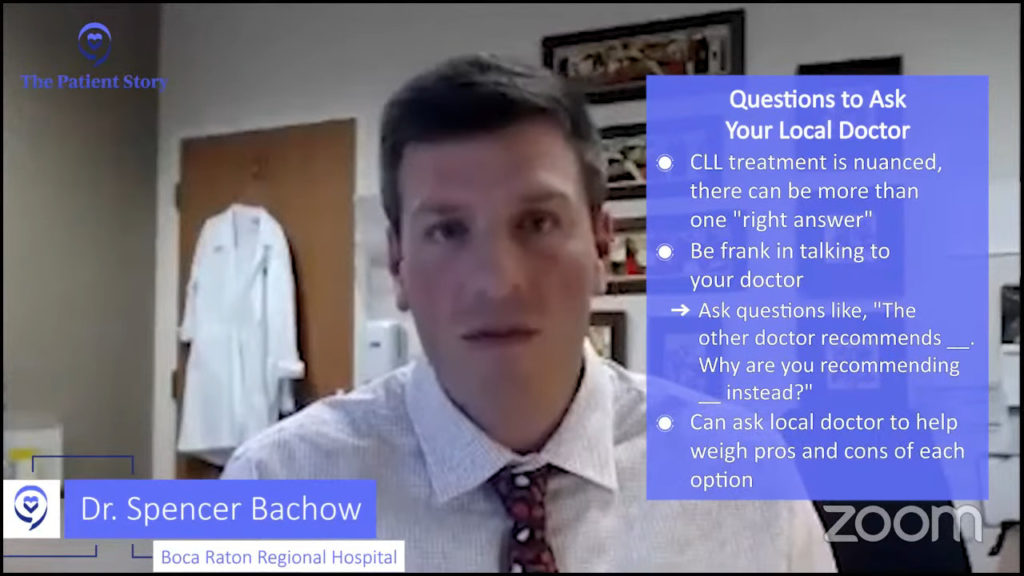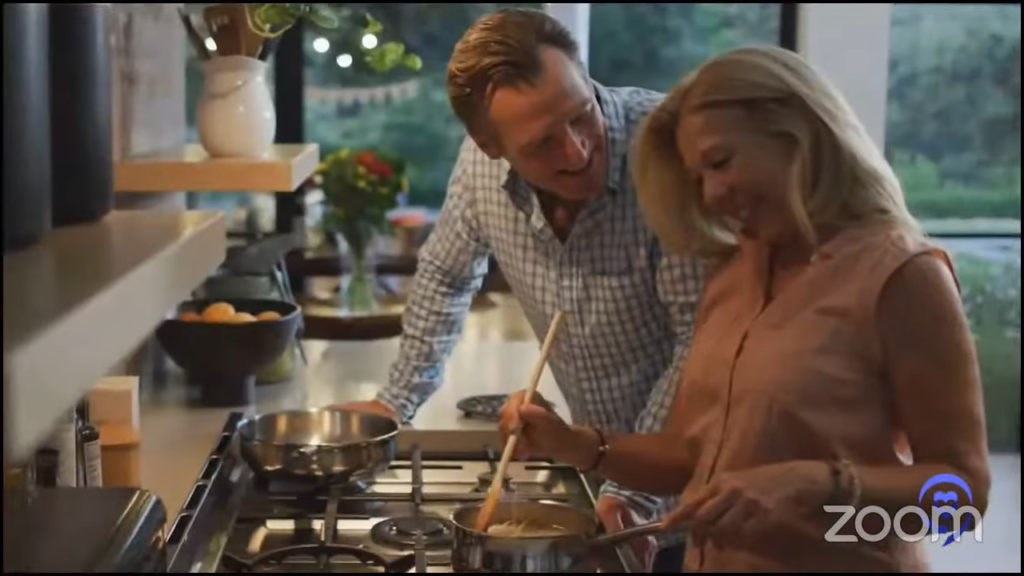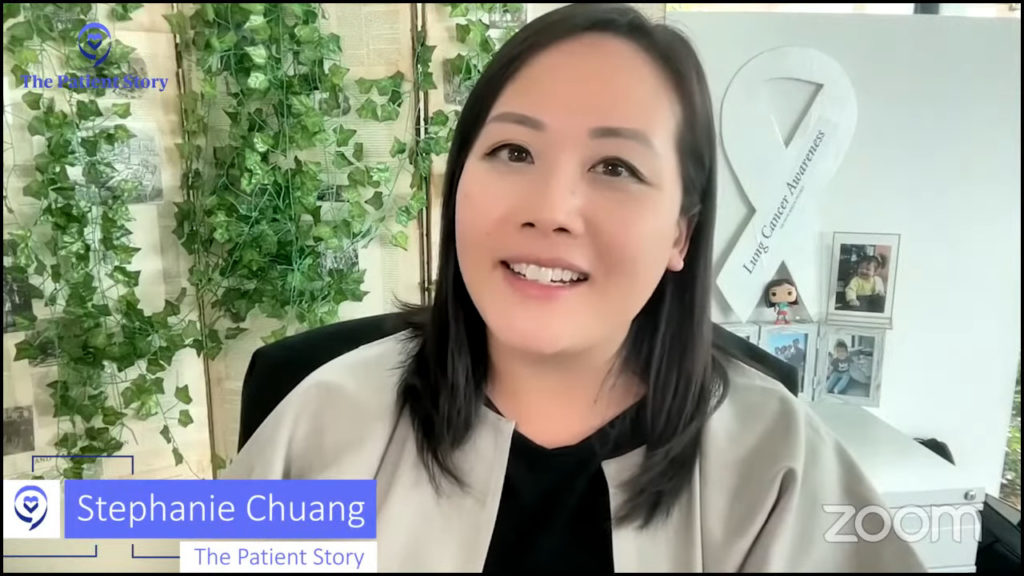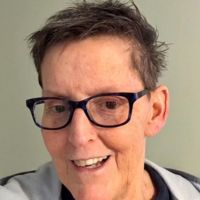CLL Treatment Advances: Moving from Research to Reality
Targeted Therapies, Breakthrough Combinations, and Minimal Residual Disease (MRD)
The world of CLL treatment is evolving fast, with new breakthroughs offering more options and greater precision than ever before.
This program brings together expert Dr. Jeff Sharman and patient advocate Andrew Schorr to break down the most important updates from recent research and clinical trials. Learn what’s changing, how it impacts treatment decisions, and what it all means for patients today.
New Treatment Advances: Get the latest updates on targeted therapies, combination approaches, and next-generation treatments.
Understanding MRD: Learn how minimal residual disease (MRD) testing is shaping treatment strategies.
Clinical Trials & Personalized Care: Discover how biomarkers and ongoing research are changing the CLL treatment landscape.
Expert Insights & Patient Focus: Hear from Dr. Jeff Sharman and Andrew Schorr on what this means for patients now and in the future.


We would like to thank The Leukemia & Lymphoma Society and the CLL Society for their partnerships.
This interview has been edited for clarity and length. This is not medical advice. Please consult with your healthcare provider for treatment decisions.

Thank you to AbbVie for its support of our independent patient education program. The Patient Story retains full editorial control over all content.
Edited by: Katrina Villareal
- Introduction
- What Happens After a CLL Diagnosis?
- The Latest Treatment Options for CLL
- What is Pirtobrutinib?
- What is a Degrader?
- CLL Treatments Being Studied Now
- Deciding When to Use a Combination of Drugs for Treatment
- What is CAR T-cell Therapy?
- Working with Your Doctor to Decide on a Treatment
- When Do Doctors Decide to Start Treatment?
- CLL and Fertility Concerns in Younger Women
- Addressing Side Effects with Your Doctor
- What is Richter’s Transformation?
- How Do Doctors Treat Younger Patients with CLL?
- Considering a Clinical Trial for CLL
- Concerns About Funding for CLL Research
- Is There a Cure for CLL in Sight?
- Conclusion
Introduction
Stephanie Chuang: Welcome to “CLL Treatment Advances: Moving from Research to Reality,” a program focused on all of the latest in research and clinical trials in the world of CLL treatment. It’s a space that we know has experienced so much development in the last few years especially. While that’s incredible news, it also means that there might be more questions about CLL treatment options. We are featuring some incredible CLL advocates on the topic from both the specialist side and the patient side.
I’m the founder of The Patient Story and I was diagnosed with a different kind of blood cancer, an aggressive form of non-Hodgkin lymphoma. While I was undergoing hundreds of hours of chemo, the idea for The Patient Story came up. I thought that other people would want humanized information the way that I did and that’s what we try to do. We help people navigate life at and after diagnosis in human terms and build community through in-depth patient stories and educational discussions.
We want to thank our sponsor, AbbVie, for supporting this program, which helps us host more of these discussions for free. I want to stress that, as always, The Patient Story retains full editorial control over all content. While we hope that this is helpful, keep in mind that this is not a substitute for medical advice so still consult with your health team about your decisions.
There’s so much to get through, so I will hand it over to someone many of you are very familiar with and who I’m proud to say has become a friend of mine, Andrew Schorr.

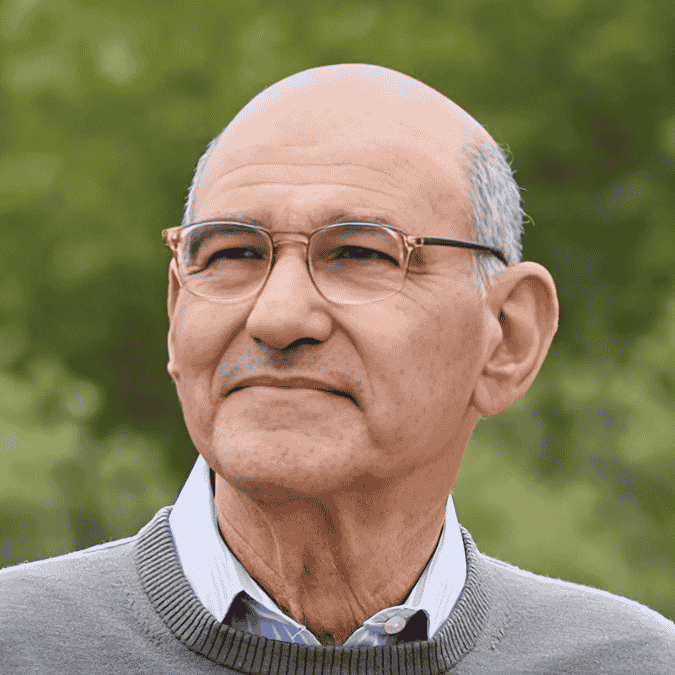
Andrew Schorr: Hello and welcome to this program. We’re going to discuss the latest in CLL, particularly based on one of the big medical meetings that happened not too long ago where a lot of studies came out. What does it mean for all of us? I’m in San Diego and I’ve been living with CLL since 1996.
Joining us from Eugene, Oregon, is a leading expert in CLL, Dr. Jeff Sharman. Jeff, who I’ve known for many years, is at the Willamette Valley Cancer Institute and Research Center. He’s also the medical director of hematology research for the Sarah Cannon Research Institute. Jeff, it’s great to see you.
Dr. Jeff Sharman: It’s great to be back with you, Andrew. Thanks for having me.


What Happens After a CLL Diagnosis?
Andrew: Jeff, I’ve been living with CLL for many years. Some people who will watch this program are newly diagnosed. I went through all the stages and I’m sure you see it in your practice daily. “What the hell is this? I’m scared. I have a blood cancer. Will my life be shorter? Am I going to die anytime soon? What do you have that’s effective to treat me? If that doesn’t work, do you have something else?” We’re going to get into all that, but at a high level, Jeff, how do you feel for today’s patient?
As a doctor, one of the things is figuring out how to administer the most unique medicine we give, which is the medicine of hope
Dr. Jeff Sharman
Dr. Sharman: I have a very large practice. I take care of about 400 CLL patients and for many of them, I’ve been their first doctor. That’s the nature of my practice. For a lot of folks I take care of, I’m their first contact in terms of understanding CLL.
What you highlighted is something I see time and time again, which is a very understandable fear patients come in with. It’s very common. You say leukemia and you see their eyes widen and see them sit up a little straighter. What you recognize is a great deal of distress that any cancer would cause. As a doctor, one of the things is figuring out how to administer the most unique medicine we give, which is the medicine of hope, and communicate that with patients in the midst of some of the worst days of their lives.

I do reference quite frequently a study done in the Italian group, which showed that if you’re age 65 and above diagnosed with CLL, you can’t measure a statistical impact on survival. Most patients are going to outlive their diagnosis and that’s an optimistic message. Most patients aren’t going to pass away from their disease and that bears out from my experience. The number of patients who die from complications of CLL is a very small fraction. Even in my large CLL practice, it’s only a small number; two or three per year might be the case. We have a lot of treatment options for CLL apart from the traditional chemotherapy. We have targeted agents, immunotherapy, and so forth.
Most patients are going to outlive their diagnosis and that’s an optimistic message.
Dr. Jeff Sharman
Andrew: The bottom line is most of us are going to live a pretty normal life. We may need to take medicines along the way, but we have more effective medicines than ever before and others that are very promising.

The Latest Treatment Options for CLL
Andrew: I was diagnosed in 1996, but I wasn’t treated until 2000. At that time, the feeling was that treatment might be more harmful than waiting and seeing what happens. There’s still a percentage of patients who never need treatment.
I was in a clinical trial of fludarabine and cyclophosphamide with rituximab. It led to a 17-year remission, but it had the chemo component. I had a treatment that sometimes comes into play years later, which was high-dose methylprednisolone with obinutuzumab. That was about seven years ago and I’ve never had any treatment since then.
Each year, there are several meetings where you discuss the latest in research in CLL, but the big meeting in December 2024 was the American Society of Hematology meeting or ASH. The impression I had, Jeff, was we have several approved therapies, but we have what looks like planes circling the airport at different altitudes — stage 1, stage 2, stage 3 — that are very promising and are waiting in the wings for CLL. We will get into the details, but am I right that we have a lot coming?

Dr. Sharman: A lot is coming, Andrew. At these meetings, we get to see a cross-section of development. We see all those airplanes in various stages of flight. Some are coming in for landing, some are still on the assembly line, some are mid-flight, and so forth. There are severeal reasons to be optimistic about what’s out there.
Andrew: Let’s understand where we are with approved therapy. I had some chemo years ago, but you mentioned that people aren’t going to need chemo. We have this whole class of medicines — BTK inhibitors — and even new generations of that we can talk about. With the approved therapies, you have quite an arsenal now where you can use drugs either by themselves or together.

Dr. Sharman: There are three main classes of drugs. You mentioned BTK inhibitors. I would add BCL-2 inhibitors and immunotherapy, particularly obinutuzumab, which goes by the commercial name Gazyva. It took a lot of work to get each of these drugs approved. Right now, we’ve learned how to combine these drugs in terms of what we call doublet therapy, where we use two of those drugs together, and even triplet therapy, where we put three of them together. What the field is trying to figure out is the best combination and the best sequence.

The good news is these drugs are FDA-approved and available to patients. When most patients think about chemotherapy, they think of the traditional drugs developed from the 1950s through the year 2000. Those are drugs that typically damage DNA and cause cells to die as a result of damaging DNA.
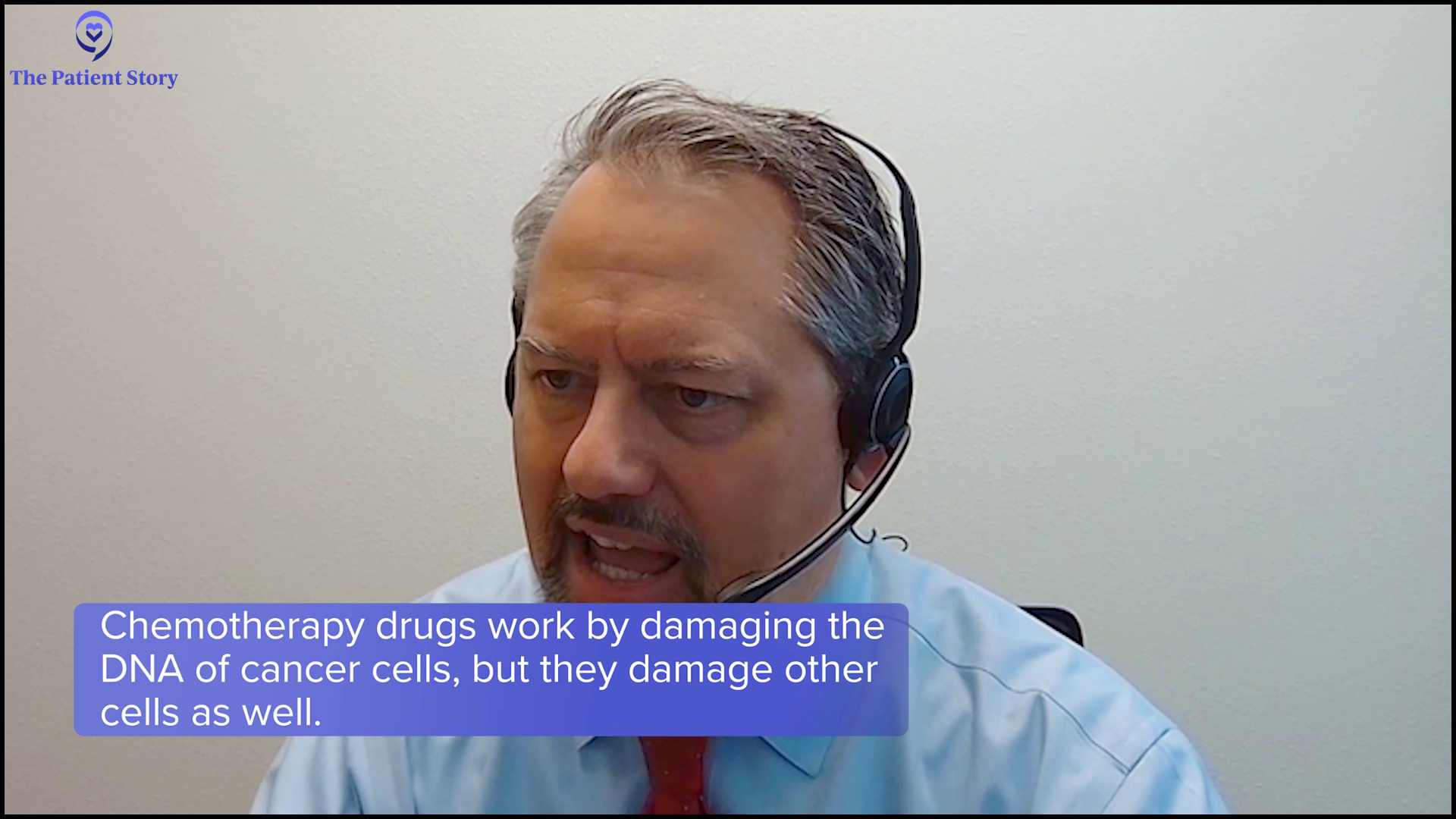
What’s different now is we have these targeted therapies, which have no DNA-damaging component but instead exploit certain vulnerabilities of the cancer cell. There’s an enzyme sequence or a signaling mechanism inside a cell. I like to think of it as an electrical current, which needs to keep going to keep the CLL cell alive. What BTK inhibitors do is cause a short circuit in that electrical circuit, so the cancer cells die as a result. It turns out that the cancer cells are more sensitive to it than normal healthy B cells. It’s a targeted therapy. It doesn’t damage DNA. It exploits a certain vulnerability.

BCL-2 inhibitors are similar in that the cancer cells are dependent upon this enzyme called BCL-2, which helps keep the cell alive. If we disrupt BCL-2, it’s almost like taking off the fence from around the Grand Canyon — they fall in and the cancer cells die as a result. It gets rid of the safety mechanism for the cells.

With obinutuzumab, what we’re doing is recruiting the immune system to fight off the cancer of the immune system. It’s as though we’re giving the immune system the tools it needs to fight off the cancer that’s already there.

Each of these drugs has its side effects. There’s no such thing as a drug that doesn’t have side effects, but in contrast to traditional chemotherapy, it’s not the same type of patient experience. These aren’t nausea-provoking drugs and they certainly don’t cause hair loss. In a lot of cases, these drugs are pretty easy to take side by side with the rest of your medications and you might not necessarily know there’s something unique about it, if that makes sense.

Andrew: As far as BTKs, we have ibrutinib (Imbruvica), acalabrutinib (Calquence), zanubrutinib (Brukinsa), and pirtobrutinib (Jaypirca). For BCL-2, we have venetoclax (Venclexta) and others in development. Many people are taking BTKs now. How do you determine who gets what?

Dr. Sharman: There’s a lot of terminology around first-generation, second-generation, and third-generation. We’re researching fourth-generation BTK inhibitors.

The very first BTK inhibitor to come about was ibrutinib, which turns off the BTK enzyme in a unique way. It forms a bond with the BTK molecule, which we call an irreversible inhibitor or covalent inhibitor. It forms a permanent attachment to the BTK enzyme so that particular enzyme will never work again until the cancer cell makes a new one. Cancer cells make new ones and in about 24 hours, they’re starting to wake up their BTK, which is why ibrutinib is taken once a day. The new enzyme needs to be shut down, just like the old enzyme was.

There are some unique side effects with ibrutinib. We see an increased rate of bruising and bleeding, which tends to be mild arm bruising. For most patients, it doesn’t prove to be all that much, but a lot of our patients are already on blood thinners so if you start adding them together, the risk of bleeding goes up. We see some joint aches and muscle cramps happen. Occasionally, patients can have an abnormal heart rhythm called atrial fibrillation. Originally, we didn’t know if that came from the drug, but we’ve largely concluded now that it does.

That left room for the second-generation BTK inhibitors, acalabrutinib and zanubrutinib. These medications underwent more rigorous pre-clinical development of medicinal chemistry to try to dial out some of those side effects. In fact, acalabrutinib and zanubrutinib have been compared head to head against ibrutinib in various studies and have shown fewer side effects for most patients and some increased efficacy. Within the field, most doctors who follow this area closely tend to start patients on either acalabrutinib or zanubrutinib.

How do we pick? Sometimes it’s an insurance issue. Sometimes you might have some bias. The cardiac differentiation is a bit in favor of acalabrutinib. In the head-to-head study where zanubrutinib was compared to ibrutinib, there may be a signal of higher efficacy. If you’re going to combine it with obinutuzumab, you go with acalabrutinib. There are various reasons you might pick one over the other. Sometimes it comes down to insurance, but I view acalabrutinib and zanubrutinib as more similar than different.

What is Pirtobrutinib?
Andrew: You used the term covalent. I understand there are non-covalent BTKs and I believe pirtobrutinib is one of those. What’s the difference?
Dr. Sharman: We talked about acalabrutinib and zanubrutinib as second-generation BTK inhibitors because they differentiate from ibrutinib. We consider pirtobrutinib a third-generation BTK inhibitor.
When we talk about the different generations, what’s the main difference? It’s a non-covalent inhibitor. Over time, patients can develop resistance to the first- and second-generation BTK inhibitors and the most common way they do that is by modifying the exact spot on the BTK enzyme where the first- and second-generation BTK inhibitors bind. There’s an amino acid in position 481 called cysteine that can get mutated. All of a sudden, those drugs don’t work. There are other mutations, but that’s the most common one.

Pirtobrutinib does not require forming a bond. It stays in the system a little bit longer, fits into the binding pocket more easily, and doesn’t require that irreversible bond. Pirtobrutinib has been shown to work even after patients have developed resistance to the first- and second-generation BTK inhibitors and that’s what differentiates it as a third-generation BTK inhibitor.
Another one in late development is called nemtabrutinib, which may or may not get approved — I suspect it will. It may still be a little ways away and has flown under the radar a little bit. The distinct advantage of non-covalent inhibitors is they can continue to inhibit the BTK enzyme even after the first- and second-generation BTK inhibitors have stopped working.

What is a Degrader?
Andrew: Some of our patients are like mini scientists and are asking about degraders. What are degraders? I know we don’t have them approved yet, but where are they going to fit in?
Dr. Sharman: They would be a fourth-generation BTK inhibitor. I’ll take the cloud-level view. One paradigm in all of oncology is that when you find a good target, a good enzyme to inhibit, or a good surface target, there are always efforts to continue to exploit the therapeutic opportunity of going after that target in new and improved ways. Clearly, one of the improved ways is to work when the other drugs stop working.
BTK degraders get rid of the BTK enzyme completely instead of turning it off.
Dr. Jeff Sharman
The concept of degraders is a lot like pirtobrutinib, although it does it through a different mechanism. It’s designed to inhibit BTK even when the BTK inhibitors have stopped working. Within any cell — cancer cell or regular cell — there is trash disposal for old broken-down proteins. We are constantly synthesizing new proteins and getting rid of the old ones. Degraders glue a couple of molecules together — one that goes after BTK and then the other one designates the protein for the trash heap — and tags the BTK molecule to dispose of this enzyme. Instead of inhibiting BTK, it’s degrading BTK, which is very different. BTK degraders get rid of the BTK enzyme completely instead of turning it off.
BTK degraders are a very active area of research right now. These would be the airplanes that aren’t necessarily coming in for a landing or even mid-flight. They are still getting manufactured and haven’t taken off from the ground.

CLL Treatments Being Studied Now
Andrew: Venetoclax is a BCL-2 inhibitor, which is a different mechanism of action. There are other BCL-2s in development as well. What are some of the names?
Dr. Sharman: Sonrotoclax is probably the one that’s farthest along. There have been a handful of other BCL-2 inhibitors that have gotten out there. Venetoclax is an incredibly effective drug. In fact, it’s so effective that its effectiveness may almost be its biggest liability. It can literally kill cancer cells so fast that the consequences of that can be some electrolyte abnormalities and disturbances that can be life-threatening, which is what we call tumor lysis syndrome where you’re killing cancer cells too quickly. The inside of cancer cells has a lot of potassium and uric acid.

Andrew: Your kidneys can’t keep up.
Dr. Sharman: You can’t keep up. It can clog up the kidneys, cause heart arrhythmias, and so forth. With venetoclax, we start with a very low dose of 20 mg for a week. The following week, we go up to 50 mg. The week after, we go up to 100 mg. Then 200 mg. Patients generally go on 400 mg.

It also has some drug interactions, more for our patients who have acute myelogenous leukemia (AML) or patients on cardiac medications. What we have to do is check labs frequently. We stratify the risk for these patients. Are they low risk, intermediate risk, or high risk? That has to do with how high their white blood cell count is, how big their lymph nodes are, and how their kidneys function, so we follow these patients closely. For a lot of patients, it’s a month with a lot of lab visits. Sometimes, we even put patients in the hospital when we start the medication because we want to be able to jump into gear if they’re high risk.

It has logistical challenges. It’s not used quite as frequently in the front-line setting as BTK inhibitors, which are oftentimes quite simple to give, but it’s a very effective drug. One of the big advantages is it gives very deep remissions. Oftentimes, we’re able to give patients the drug for one year in the front-line setting, two years in the relapse setting, and then stop the medicine. Patients can have remissions that can last multiple years without requiring ongoing therapy. Whereas with BTK inhibitors, once we start them, patients always ask, “Am I going to be on this forever?” I say, “You’re going to be on it as long as it’s working for you.” For many patients, it can be from five to 10 years, which feels like a long time to be on an anti-cancer medicine for patients.
Patients can have remissions that can last multiple years without requiring ongoing therapy.
Dr. Jeff Sharman
Deciding When to Use a Combination of Drugs for Treatment
Andrew: Let’s tie this together. We have BTK inhibitors that work for most people and depending on the side effects you might experience, the health of your heart, or other issues you might have, your doctor would work with you to choose one that’s the kindest on your body. You might combine it with another drug. You talked about doublets or even triplets, so somebody might receive one of these drugs with obinutuzumab. Would somebody get a BTK and a venetoclax?
Dr. Sharman: That leads us to some of the discussions at the 2024 ASH meeting. If we go back in time to a couple of meetings ago, we saw data for the combination of ibrutinib and venetoclax that was compared against one of the standards at that time, which included obinutuzumab with a chemotherapy drug that’s not used much anymore called chlorambucil. The ibrutinib-venetoclax clearly beat obinutuzumab-chlorambucil and interestingly, we had a different opinion depending on where you are in the world as to whether or not it could be approved. That combination was approved in most of Europe and is reimbursed by insurance in several jurisdictions. In fact, ibrutinib-venetoclax is a very common regimen utilized in Europe.
The combination of acalabrutinib-venetoclax or the triplet acalabrutinib-venetoclax with obinutuzumab was compared against two of the harder chemoimmunotherapy regimens.
Dr. Jeff Sharman
Interestingly, there was a different take on the US regulatory environment. There were some technical reasons that had to do with some of the side effects of combining ibrutinib with venetoclax. Diarrhea was considerably more common and this was in an older population. It was a harder regimen in older patients. The US did not approve it.
You have this difference between the US and Europe. The combination of ibrutinib-venetoclax is not used much in the United States outside of some studies. It does have an endorsement by the National Comprehensive Cancer Network (NCCN). Oftentimes, you could get it, but it leaves a window of opportunity for other BTK inhibitors, which gets us into some of the discussion at the 2024 ASH meeting.

The combination of acalabrutinib-venetoclax or the triplet acalabrutinib-venetoclax with obinutuzumab was compared against two of the harder chemoimmunotherapy regimens, either fludarabine, cyclophosphamide, and rituximab (FCR) or bendamustine-rituximab (BR). In both experimental arms, the doublet (acalabrutinib-venetoclax) and the triplet (acalabrutinib-venetoclax with obinutuzumab) beat chemoimmunotherapy.
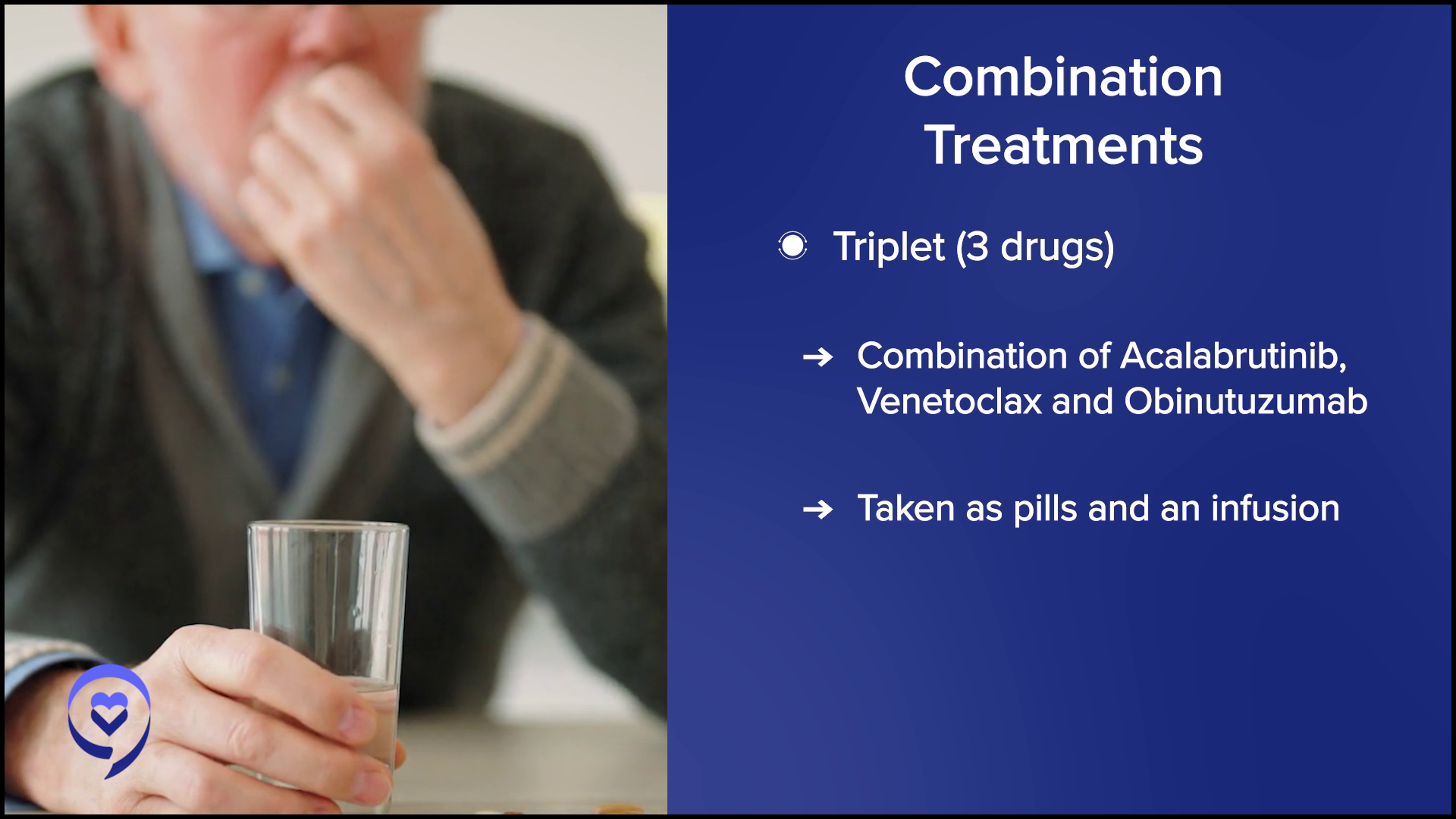
Within the field, there’s an expectation that there will be approval fairly soon for acalabrutinib-venetoclax with or without obinutuzumab, which is attractive to patients because it’s an all-oral regimen. You take the acalabrutinib for a while before you start the venetoclax. It cuts down on the risk of tumor lysis quite a bit. It’s convenient, effective, and fixed duration, so patients don’t take it until it stops working. There are a lot of advantages to that combination and it’s one of the things that we’re expecting to get an approval by the FDA sometime in 2025.

Andrew: To be clear though, obinutuzumab is an infused therapy.
Dr. Sharman: Yes, obinutuzumab is an infused therapy. The triplet includes obinutuzumab, which is an infused therapy.
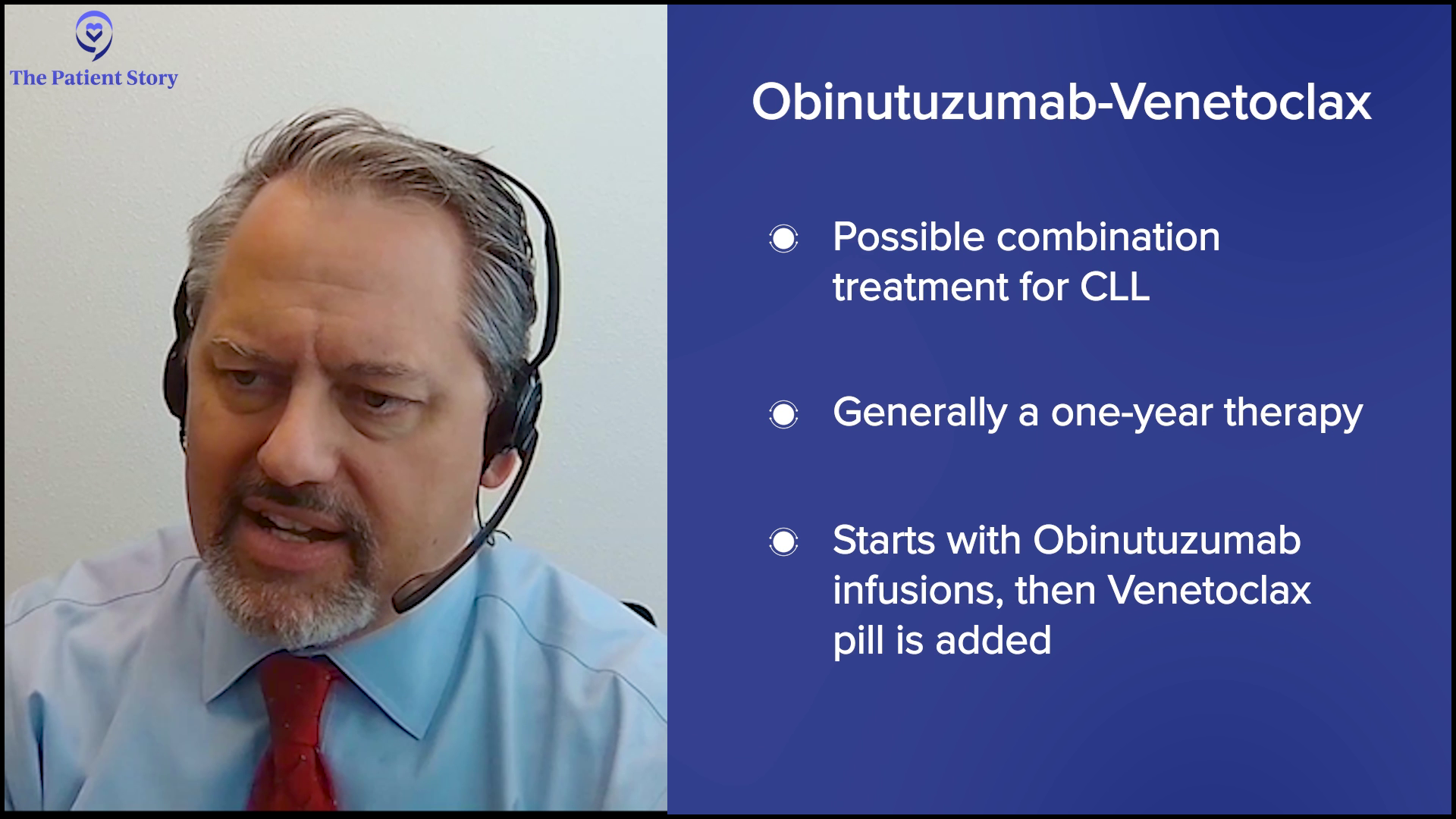
Andrew: Jeff, it sounds like we’ve got lines of therapy. We have people who you might start on a single drug. You might have a discussion with a patient about fixed duration, putting two drugs together, taking them for a while, and if you can get their disease undetectable or very low, they can stop and see how long that goes. That might be attractive.
Dr. Sharman: We haven’t talked about obinutuzumab-venetoclax as another doublet. We’ve talked about BTK inhibitors. We’ve talked about venetoclax. Most of the time, once somebody starts a BTK inhibitor, they stay on it until it stops working.
Obinutuzumab-venetoclax is generally considered a one-year therapy. Patients start with obinutuzumab, get a sequence of several infusions, and continue on it for a total of six months. We start venetoclax somewhere around month two and go through a careful ramp-up. For those patients, we generally can stop at 12 months. For the molecularly favorable, they may not need therapy for another five, six, or seven years. For some of the higher risk, like the IGHV unmutated population, those remissions might not last quite as long. But one of the big things in the field right now is: what’s the optimal doublet?
Most of the time, once somebody starts a BTK inhibitor, they stay on it until it stops working.
Dr. Jeff Sharman
We have obinutuzumab-venetoclax. We’re likely going to have the approval of acalabrutinib-venetoclax. Which of the two would you rather do? There might be different reasons for different patients. I’m excited about the MAJIC study, which we helped design and lead. The study directly compares obinutuzumab-venetoclax to acalabrutinib-venetoclax. We’re going to learn a lot from that. Do you take it for one year or two years? All oral or IV? That’s one of the big questions in the field. If I’m going to pick a doublet, which two do I pick?

What is CAR T-cell Therapy?
Andrew: Some people will progress and there’s one kind of treatment we haven’t talked about yet: CAR T-cell therapy. Where do we stand with that? My friend Dr. Brian Koffman, who’s gone through many different therapies, had CAR T-cell therapy. It’s a big gun. Where does that fit in for people who don’t do so well on some of these other drugs?
Dr. Sharman: CAR T is an amazing science, Andrew. It’s so amazing to see. The concept here is that we have a patient go through a one-day procedure that is conceptually like dialysis. We take out and isolate their T cells then ship those T cells to a lab. They get reprogrammed in part by the use of a virus that’s been engineered to give the cell different instructions. The cells get manufactured, expanded, and infused back into the patient. It’s amazing, Andrew. The CLL cells get destroyed by these reprogrammed T cells and patients can get very deep remissions.
Now, this is a technology that’s not unique to CLL. In fact, it was first used in CLL and acute lymphoblastic leukemia (ALL). The development in CLL stalled a little bit. But in other diseases, such as diffuse large B-cell lymphoma (DLBCL) and ALL, we feel very comfortable as a field saying that CAR T-cell therapy can be curative in those settings. It is too early to say whether it can be curative in CLL or not. My professional opinion is that for some patients, it could be.
Right now, [CAR T-cell therapy]’s only approved for patients who’ve had both a BTK inhibitor and a BCL-2 inhibitor, but it’s been an effective therapy for a number of my patients.
Dr. Jeff Sharman
The clinical trial that led to the approval of CAR T-cell therapy took the worst of the worst patients who were extraordinarily sick. The data that led to the approval wasn’t the most impressive or compelling; it limped across the finish line. That said, sometimes we design studies to get a drug approved by the FDA and then how we use them in the real world can differ. The opportunity with CAR T-cell therapy may exceed the perception from the study that led to its approval.
Who’s it right for? The reality is a lot of older patients with CLL may not ever need it. Give them a pill, send them on their way, and they’re going to be fine. But the younger they are, the more aggressive the disease, or the combination of young patients with aggressive disease, CAR T-cell therapy is something that needs to be factored into their thinking earlier on. Right now, it’s only approved for patients who’ve had both a BTK inhibitor and a BCL-2 inhibitor, but it’s been an effective therapy for a number of my patients.
We think about treatment sequencing… You need to almost have a game plan in mind for somebody from the outset.
Dr. Jeff Sharman
Working with Your Doctor to Decide on a Treatment
Andrew: In 1996, when I started talking to Dr. Kanti Rai, one of the grandfathers in CLL in clinical research, there wasn’t much to talk about. I said, “Dr. Rai, it seems like you have a lot of furniture in the room and you’re trying to figure out where to put the couch, where to put the easy chair, and how to move things around.” It sounds like that’s where you are now, except you have more furniture.
Dr. Sharman: We’ve lived in the house longer, so it’s more cluttered, and we’ve upgraded the couch.
Andrew: I’m sure there are patients whose heads are spinning. Not all CLL patients are the same and treatment is an individualized choice.
Dr. Sharman: Absolutely. There are some patients who, from the physician’s perspective, I would say, “Oh, this is what we’re doing.” Then there are other patients who are very involved in their care and want to be involved in the decision-making. That’s great and they should be involved.
A patient might have preferences, but I may have different preferences based on how I’m thinking. Sometimes it’s a matter of calling to attention some of the potential side effects in a certain circumstance. Maybe somebody wants to do a fixed duration, but their kidneys aren’t doing well, they have bulky disease, or other reasons why we might pick one over the other.
We think about treatment sequencing. If we’re going to pick this first, what’s the patient going to look like five to seven years from now when we might need to do a second therapy? You need to almost have a game plan in mind for somebody from the outset.

When Do Doctors Decide to Start Treatment?
Andrew: I went four and a half years without treatment and felt pretty good. Then I started to develop some lymph nodes and my white blood count fueled by lymphocytes went up to about 283,000. My friend Dave has a white blood count that’s even higher than that, but he hasn’t had treatment and feels fine. When do you start treatment for a new patient?
Dr. Sharman: Back in the 1950s, steroids were a new thing. This was a byproduct of World War II and we were giving steroids to patients with CLL. In some original manuscripts, patients were getting white blood cell counts of 1.5 million, a number we would never see today. Patients always want to know: At what white count do I need to intervene? The answer is: There isn’t a white count where you need to intervene.
We look at the lymphocyte doubling time (LDT). When that number goes up more than twofold in less than six months, that’s our clue that we need to do something.
Dr. Jeff Sharman
You see doctors get squeamish at different thresholds. If you’re a non-CLL doc, you start to get squeamish around 100,000. If you’re a CLL doc, 200,000 or 300,000 will start to make you nervous. If you’ve been around the block a long time, you have patients who come into your clinic with a white count of 600,000 who are stable. You get desensitized to it.
It’s not a number; it’s a rate of change. It’s not about whether you hit 100, 200, 400, or 600; it’s how quickly your numbers are increasing. For a patient who’s climbing quite rapidly, we look at the lymphocyte doubling time (LDT). When that number goes up more than twofold in less than six months, that’s our clue that we need to do something.

There are other reasons we might treat somebody. When they have bulky lymph nodes, start developing marrow dysfunction, get anemic or their platelets are starting to go down, those can be reasons to intervene. If you treat a lot of CLL, you see some weird ones. I had a patient who had direct kidney involvement with the CLL and had significant kidney problems; that’s not a very common one.
What comes up periodically is fatigue. Some patients have disabling fatigue. They might be 55 years old. They’re not depressed. Their thyroid is fine. They’re not iron-deficient. But they can only go to work for four hours before they have to come home. Disabling fatigue is a reason to treat. These are all pretty well spelled out in the iwCLL criteria: rate of change, symptomatic, bulky lymph nodes, marrow dysfunction, and others. Those are the reasons we treat patients.
I have had some young women, one or two in particular, who were diagnosed at childbearing potential. It’s fine to have kids.
Dr. Jeff Sharman
CLL and Fertility Concerns in Younger Women
Andrew: Another thing that people wonder about is if they’re told they’re diagnosed with CLL and they’re younger and female, would you tell them not to get pregnant?
Dr. Sharman: It hasn’t come up all that much because most women, if they’re going to have kids, will do so before their mid-40s or even younger. The typical age of diagnosis of CLL is 72 with the first line of therapy typically at 74, so it’s not a common scenario. That said, I have had some young women, one or two in particular, who were diagnosed at childbearing potential. It’s fine to have kids. It doesn’t come up often, but it’s not a contraindication.
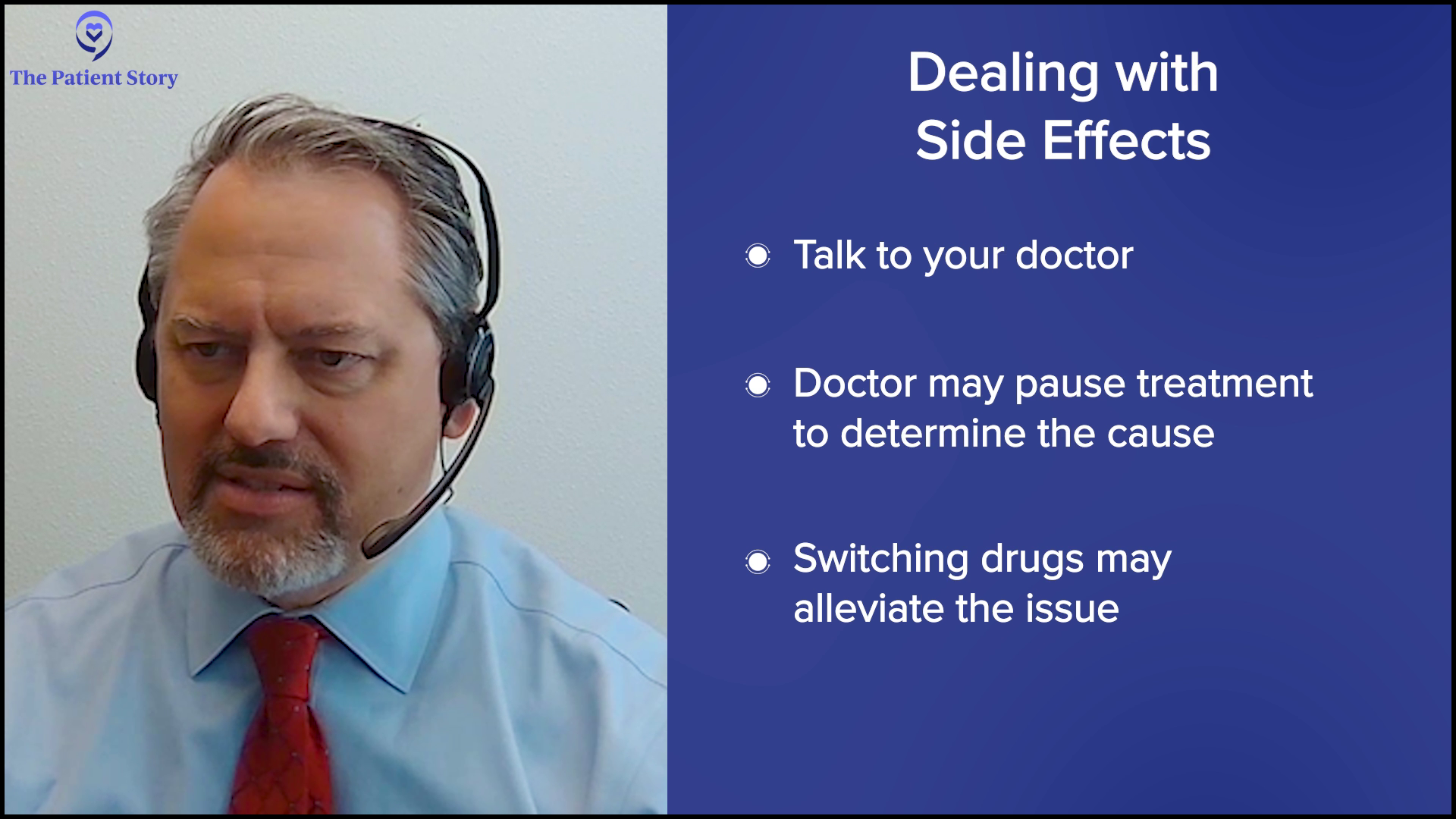
Addressing Side Effects with Your Doctor
Andrew: We had people who wrote that they had a back rash, a migraine, or this or that. Is it because of the drug they’re taking for CLL, is it the CLL, or is it something else? How do you determine if it’s the drug, the illness, or something else?
Dr. Sharman: There’s obviously no uniform answer to all of that. It’s going to take a close relationship with your oncologist. I always invite my patients to ask questions and do my best as a clinician to say, “Yep, I own that one,” or, “Nope, I don’t think that’s me,” and call balls and strikes. I figure if I’m honest with it and own up to something, then they’ll believe me when I say it’s not on me.
As doctors, we don’t always know. Sometimes it takes working it out together with your patient about how you solve this.
Dr. Jeff Sharman
Even if I’ve done this for a long time, there are times when we don’t know. Sometimes you have to hold the drug for a little while, see if it gets better, restart it, and see if it comes back. You can do that with side effects that are of lower consequence. If it’s a major side effect, like a hemorrhage, that’s a different story altogether. As doctors, we don’t always know. Sometimes it takes working it out together with your patient about how you solve this.

What is Richter’s Transformation?
Andrew: Jeff, there’s a small percentage of patients where you talked about aggressive disease and there’s something called Richter’s Transformation. Could you explain that? One of the patients who wrote in is worried about that.
Dr. Sharman: Richter’s Transformation is a potential complication of CLL that is definitely more concerning. It’s generally when the CLL cell acquires a more aggressive behavior and becomes DLBCL, which is a different entity altogether. It requires a different treatment approach. Generally speaking, we reach for more traditional chemotherapy in that setting. In some cases, it can be fairly resistant to therapy. It’s a disease that can move very quickly.
Richter’s Transformation is rare… But if you’ve had the disease for 20 years, that risk starts to build up.
Dr. Jeff Sharman
If it’s suspected, the clinician has to jump into gear quickly. It requires a biopsy because you have to get a biopsy and prove that it’s not Richter’s Transformation quickly. Most often, you see a lymph node that’s swelling very quickly and disproportionate to the others. If you’re going to get a PET scan, it’s oftentimes bright on a PET scan. These are the things we’re thinking of as a clinician.
Fortunately, Richter’s Transformation is rare. It’s seen in about 1% of patients per year. But if you’ve had the disease for 20 years, that risk starts to build up. It probably hits a plateau at around 15 to 20%.
Sometimes, Richter’s Transformation is misdiagnosed. If you stop somebody on a BTK inhibitor, oftentimes their nodes will increase pretty quickly thereafter and in that circumstance, I’ve seen cases where Richter’s may have been inaccurately diagnosed. It requires a certain degree of suspicion if you’ve got a biopsy right after starting BTK inhibitors.

How Do Doctors Treat Younger Patients with CLL?
Andrew: I know this is complicated for people. We discussed that if you haven’t had treatment, you don’t treat the number; you look at the overall patient. You have a variety of medicines. BTK inhibitors are used by themselves or in combination, and there are different generations. We have clinical trials for some of these treatments mentioned at the 2024 ASH meeting. There are phase 1 trials for BTK degraders. CAR T-cell therapy is for people with more aggressive disease, although we’ll see if that creeps up a little earlier for younger patients.
Some people on Facebook, for instance, are under 50 with CLL and I know it’s not the most common. Is their age of diagnosis a bad thing? Are they going to have a rougher time with CLL because they’re diagnosed younger? Will they not live as long? What do you tell a younger patient based on their age?
Our therapies are as effective in younger individuals as they are in older individuals… we need to come up with something that’s going to keep this disease in control for quite a bit longer.
Dr. Jeff Sharman
Dr. Sharman: For these patients, we have to plan not only for the next 10 to 15 years but also for the next 30 years. To some degree, we celebrate that we have a lot of new tools to control the disease. It is a reasonable question to ask: Can you use these tools to control it for twice as long or three times as long as somebody who’s diagnosed at age 80? It’s a different game plan.
Our therapies are as effective in younger individuals as they are in older individuals and in some cases, maybe even more effective in younger individuals. But it does require some thoughtfulness to think about the fact that we need to come up with something that’s going to keep this disease in control for quite a bit longer.
The field is moving so fast that the tools we’ll be using five to seven years from now may not even have been conceived of at this point. If somebody’s diagnosed younger, it’s fair to assume that there will be more tools in the tool shed down the road.
There’s a general misperception that you would only do a clinical trial if you’re running out of options but it’s not the case at all.
Dr. Jeff Sharman
Considering a Clinical Trial for CLL
Andrew: Some of your patients are on clinical trials. When someone meets with their CLL doctor, should clinical trials be part of the discussion? Do you lay all this stuff out and then say what are in trials that they should consider as well?
Dr. Sharman: Andrew, we treated the very first CLL patient in the world with ibrutinib in my clinic and I’ve been a believer ever since. In many cases, we’re so grateful for patients who’ve volunteered for studies in the past because they’re the ones who’ve moved this field forward.
Clinical trials are not a one-size-fits-all scenario. There’s a general misperception that you would only do a clinical trial if you’re running out of options but it’s not the case at all. There are great studies for previously untreated patients, patients on first relapse, and patients who are resistant to certain treatments. In many cases, for the last 15 to 20 years, some of our best options have only been available in research studies.
It calls for a unique answer for every patient and what sort of studies might be available and accessible to them, but I would definitely like to dispel the notion that it’s only a therapy for patients who’ve run out of options.
Andrew: I was in a phase 2 trial in 2000 for FCR and it led to a 17-year remission, for which I’m very grateful. Would I have had that otherwise?

Concerns About Funding for CLL Research
Andrew: There are challenges about funding for research and researchers are worried. From the point of view of a CLL patient or CLL researcher, do you have a concern where that throws cold water on progress for CLL?
Dr. Sharman: It’s a great question and a sensitive discussion. People are going to have different opinions on this. The funding environment is shifting and I don’t know if we totally understand all the implications. It is worth noting that many studies are supported by the pharmaceutical industry. I know that the pharmaceutical industry is oftentimes considered a bad word, but they’ve been the friends that have brought us a lot of progress in the last handful of years.
The funding environment is shifting and I don’t know if we totally understand all the implications.
Dr. Jeff Sharman
For studies that are sponsored by pharmaceutical companies, these are oftentimes trying to develop a new drug or getting a new drug approved, so I don’t see much impact there. But when it comes to academic, university-based exploratory studies that are grant-funded, some of those will be impacted and some of the basic science research is up in the air right now. People don’t know if grants are going to be renewed or not. Amongst my academic colleagues, there is a great deal of concern and consternation about what the funding changes will mean. The whole story hasn’t been written yet, but like anything, it’s a nuanced answer where some areas will be affected more than others.
Andrew: How many years have you been at it, Jeff? How many years have you been in practice and seeing CLL patients?
Dr. Sharman: I finished my fellowship in 2008 at Stanford and I’ve been in practice in Eugene, Oregon, since then. Fellowship, residency, med school, and undergraduate studies all take a while. I don’t know where you start the clock, but I’m getting gray. How’s that?

Is There a Cure for CLL in Sight?
Andrew: I used to ask Dr. Keating, one of the grandfathers in Seattle, about this. Will we see a cure for CLL in your lifetime? Dr. Sharman, do you have hope for a cure?
Dr. Sharman: Unequivocally yes.
Andrew: I like that answer.
Dr. Sharman: I’ll leave it simple.
The world has changed in the last decade for what it means to be a patient with CLL and it is an area where I think hope is very reasonable.
Dr. Jeff Sharman
Andrew: I like that. When you put it all together, we have a variety of treatments that you can choose from with your patient based on their preference, your recommendations, and their clinical situation. We had some early- and later-stage research at the 2024 ASH meeting in December. Other meetings will happen during the year and then we’ll have ASH again, so we’ll get to talk again. You have different doublets and triplets, and even different ways of doing it. It sounds like there’s great hope for people.
Dr. Sharman: I couldn’t agree more, Andrew. I feel like the world has changed in the last decade for what it means to be a patient with CLL and it is an area where I think hope is very reasonable.

Conclusion
Andrew: Like you, I’ve been at this a while. I was diagnosed in 1996. I’ve seen some sick people, people who’ve been on clinical trials like me, and people on newer medicines. Most people are doing well. My CLL is at a very low level. You may be in long-term remission and though we may not be cured, go live your life. With Dr. Sharman and his colleagues doing the research and the studies that keep coming out, we have every reason to think that we can do that for a long time. Dr. Sharman, thank you so much for being with us and explaining all this.
Dr. Sharman: It’s my pleasure. Thank you so much, Andrew, and I look forward to future conversations.
Andrew: Remember: knowledge — and we’ve been getting some today — can be the best medicine of all.
Stephanie: Thank you, Andrew and Dr. Sharman, for leading this wonderful and very educational discussion at The Patient Story and taking the time out of your very busy schedules to provide such great insights.
Thank you once again to our sponsor, AbbVie, for supporting our independent patient education program. As always, we retain full editorial control. We want to point out some incredible resources from our friends at partner organizations, like The Leukemia & Lymphoma Society and the CLL Society.
The LLS has a community section for people to meet and chat with other blood cancer patients and care partners; in this case, in CLL. The LLS offers many things, but one of the free resources is the Clinical Trial Support Center. It’s free, one-on-one personal guidance throughout the process before, during, and after clinical trials, which, as we know, can be a lot.
The CLL Society has a lot of great programs, too. It’s dedicated to the CLL community and offers programs like Expert Access™, connecting patients to world-renowned CLL experts for a free virtual second opinion, which is so important, especially with all the things that are going on, as you can see from this discussion.
I hope this program was helpful and that you walk away with more knowledge and questions to ask your doctors. Thank you for coming and we hope to see you at another program. Take good care.


Thanks to The Leukemia & Lymphoma Society and CLL Society for their partnerships.

Thank you to AbbVie for supporting our independent patient education content. The Patient Story retains full editorial control.
CLL Programs
CLL Patient Stories
Serena V., Chronic Lymphocytic Leukemia (CLL)
Symptoms: Night sweats, extreme fatigue, severe leg cramps, ovarian cramps, appearance of knots on body, hormonal acne
Treatment: Surgery (lymphadenectomy)
Margie H., Chronic Lymphocytic Leukemia
Symptoms: Large lymph node in her neck, fatigue as the disease progressed
Treatment: Targeted therapy
Nicole B., Chronic Lymphocytic Leukemia
Symptoms: Extreme fatigue, night sweats, lumps on neck, rash, shortness of breath
Treatments: BCL-2 inhibitor, monoclonal antibody
Symptoms of CLL
Learn about how some of the common CLL symptoms first present themselves from patients who have been diagnosed with CLL.






